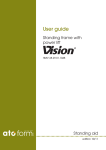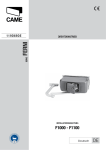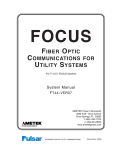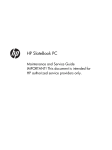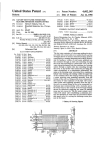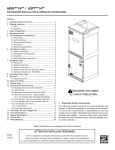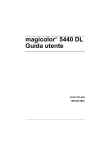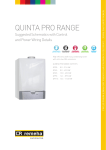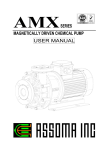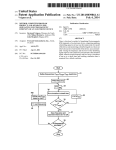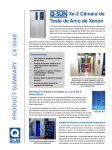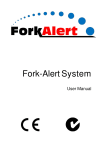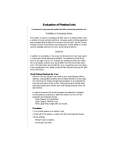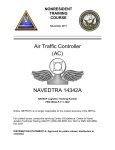Download Steam ironing device
Transcript
US 20130255114A1
(19) United States
(12) Patent Application Publication (10) Pub. No.: US 2013/0255114 A1
Ong et al.
(54)
(43) Pub. Date:
STEAM IRONING DEVICE
(75) Inventors: Chee Keong Ong, Singapore (SG);
Mohankumar Valiyambath Krishnan,
Singapore (SG); Boon Khian Ching,
Oct. 3, 2013
Publication Classi?cation
(51) Int. Cl.
D06F 75/12
(52) US, Cl,
(2006.01)
sinapore (SG); Gary Chi Yang Lim,
CPC .................................... .. D06F 75/12 (2013.01)
Singapore (SG); Wai Hong Fong,
USPC ......................................................... .. 38/77.6
Singapore (SG)
_
(73) Ass1gnee: KONINKLIJKE PHILIPS
ELECTRONICS N.V., Eindhoven (NL)
(21) APP1- NO?
13/993,544
(22)
PCT Filed:
Dec- 12: 2011
(86)
PCT N05
§ 371 (OX1),
PCT/IB2011/055597
(2)’ (4) Date;
Jun_ 12, 2013
(30)
Foreign Application Priority Data
Dec. 23, 2010
(EP) ................................ .. 101968030
(57)
ABSTRACT
A steam ironing device (1), comprising: an iron, including a
soleplate (18) provided With at least one steam outlet opening
(20); soleplate heating means (22) con?gured to heat the
soleplate (18); a steam generator (50) including a heatable
steam generation chamber (51) that is ?uidly connectable to
the at least one steam outlet opening (20) in the soleplate; and
control means (24, 56), operably connected to the soleplate
heating means (22) and the steam generator (50), and con?g
ured to control a soleplate temperature and a steam rate of the
steam ironing device, Wherein the control means (24, 56) are
con?gured to heat the soleplate to a non user-adjustable tem
perature in the range of 105-145° C., and to provide for a
time-averaged steam rate of at least 50 grams/minute.
Patent Application Publication
Oct. 3, 2013 Sheet 1 of3
US 2013/0255114 A1
Patent Application Publication
Oct. 3, 2013 Sheet 2 0f 3
US 2013/0255114 A1
Pmtaiype
2:] Reference iron
8sLco6re
85am? shirt
$55k
Jeans
9’
‘can’
‘we’
Line? iabiew-ciath Average
‘max‘
Patent Application Publication
Oct. 3, 2013 Sheet 3 0f 3
US 2013/0255114 A1
Stsam imn
Pratatype
CE Reference iron
MsTcCam
1G6% mtmn shirt
System Eran
MsTcCare
5.0
4.5
M}
3,5
3,0
25
2.6
“E ,5
1 .6
G5
{)1}
Pmtatyps
{1 Reference Eran
109% mm shirt
Oct. 3, 2013
US 2013/0255114 A1
STEAM IRONING DEVICE
ironed material if the soleplate temperature inadvertently
exceeds the maximum recommended temperature.
FIELD OF THE INVENTION
[0005]
[0001] The present invention relates to a steam ironing
device suitable for steam ironing different types of fabric.
BACKGROUND
[0002] It is a Well knoWn fact that an ironing temperature,
i.e. the temperature to Which an item that is being ironed is
heated during the ironing process, is to be chosen in depen
dence of the type of fabric of the item in order to obtain
optimal ironing results. For example, in case the item is made
of cotton, the ironing temperature may be relatively high, e. g.
around 175° C., Whereas When the item to be ironed is made
The need to be aWare of the thermal properties of a
fabric and to adjust the soleplate temperature of the iron upon
changing from one fabric type to another (if the current set
ting is unsuitable) is considered laborious and user-un
friendly. It appears, hoWever, to be necessitated by the inher
ently different thermal properties of different textiles.
[0006] In an attempt to provide for a more user-friendly
iron WO 2008/034693-A1 discloses a steam iron including a
heatable iron base, a heating device for heating the iron base,
and an integrated automatic temperature control device Which
is coupled to the heating device and designed to keep the
ironing temperature of the iron base exclusively in a ?xedly
of polyamide or elastane, the ironing temperature should be
preset, manually nonchangeable, constant ironing tempera
much loWer, e. g. about 95° C., so as to avoid scorching of the
item.
ture range from 180° C. to 190° C. during operation of the
steam iron. WO’693 teaches that all textiles, in particular
garments and household textiles, that do not include special
industry textiles can be ironed Within said temperature range
[0003]
Which approximate ironing temperature is to be
used for ironing a certain fabric type to obtain optimal ironing
results can be found in a variety of publications including
encyclopedic and/or instructional intemet Websites, ironing
device user manuals With recommendations from the manu
facturers, and patent publications. A further authorative cat
With ‘very good’ ironing results. Allegedly, ‘good’ ironing
results are still obtained When the items are dry-ironed, i.e.
Without the application of steam. WO’ 693 further advises that
textiles, Which according to EN 60311 have a maximum
egory of publications concerns international standardization
ironing temperature of 160° C. (i.e. tWo-dot-textiles, see
norms, including for example ISO 3758 (TextilesiCare
labelling code using symbols’) from the International Orga
nization for Standardization, and European Standard EN
Table 1), can be steam ironed With ‘good’ results in the said
temperature range of 180-190° C.
6031 1 (Electric irons for household or similar useimethods
[0007] Tests performed by the applicant of the present
for measuring performance’) originating from the European
application have not been able to con?rm the claims made by
Committee for Standardization and approved by the Euro
WO’693. It appears that delicate items are aWarded With a
pean Committee for Electrotechnical Standardization. The
ISO standard has introduced textile care markings for maxi
mum ironing temperatures. The textile care labelling of the
ISO standard is indicated by one, tWo and three dots placed
one-dot ironing temperature indication in their care labels for
a reason. For example, efforts to iron one-dot acrylic gar
ments using an iron at a soleplate temperature of 165° C.
Within an ironing symbol. The European Standard takes
both With and Without the use of steam, have resulted in
(indeed still safely outside the range claimed by WO’693),
account of the recommendations of the ISO standard, but to
damage to the garments in the form of permanent stiffening of
obtain improved ironing results the temperatures have been
the textile. In fact, the tests revealed that even tWo-dot items,
such as garments from polyester or Wool, are preferably not
ironed at this temperature as this is bound to lead to irrevers
adjusted as shoWn in the folloWing table:
TABLE 1
Marking
' (1 dot)
Soleplate temperature
(° C.)
Material, for example
95 r 25
acetate, elastane, polyamide,
polypropylene
" (2 dots)
130 r 30
cupro, polyester, silk, triacetate,
viscose, Wool
'" (3 dots)
175 r 35
cotton, linen
Hence, although the precise temperatures may differ, it is
generally acknoWledged that an item is best ironed at a tem
perature that corresponds to the nature of the fabric it is made
of.
[0004]
In agreement With this insight, virtually all contem
porary domestic (steam) irons come equipped With a heatable
soleplate Whose temperature is manually adjustable Within a
range of about 70-210° C. To properly iron a certain fabric
With such an iron, the user is expected to be aWare of the
thermal properties thereof, or at least of the fabric type and/or
recommended temperature settings, and to adjust the sole
plate temperature of the iron in accordance thereWith before
ible damage during normal ironing practice. In the case of a
partially polyester garment (65% polyester, 35% cotton) the
ironing resulted in stiffening of the textile, While in the case of
a 100% polyester garment the material Was observed to soften
and stick to the iron’ s soleplate. In another test the dry ironing
of a Woolen garment at a soleplate temperature of 165° C. led
to noticeable discoloration. It is expected that the thermal
damage observed in these tests Would be more pronounced if
the soleplate temperature Were raised to Within the range of
180-190° C. that is recommended by WO’693.
[0008]
The degree of damage in?icted by an iron With an
overheated soleplate may presumably be mitigated by con
tinuously moving the iron across the garment at an exception
ally rapid pace, thereby essentially preventing the transfer of
large amounts of heat from the soleplate to a single patch of
the fabric. Such ironing behavior, hoWever, is rather tiring and
Would require the average user to adjust his ironing habits. In
a practical sense, the above-described tests thus seem to
verify the commonly held belief that an ironing temperature is
best chosen in dependence of the type of fabric of the item so
as to avoid damage and to obtain satisfactory ironing results.
he starts to iron the respective textile. Disregarding the rec
[0009]
ommended soleplate temperature setting may lead to unsat
isfactory ironing results, and even thermal damage to the
unsolved, it is an object of the present invention to provide for
As the problem addressed by WO’693 is yet
an ironing device With Which different fabric types can be
Oct. 3, 2013
US 2013/0255114 A1
ironed With satisfactory ironing results, Without requiring the
user to adapt any ironing settings upon switching from one
textile to another.
time-averaged steam rate may still fall Within the range of
50-70 grams/minute. For instance, a system iron may be
con?gured to release steam in repeating cycles of 20 seconds,
each cycle including 5 (consecutive) seconds of releasing
SUMMARY OF THE INVENTION
outlet opening, and soleplate heating means con?gured to
steam at a rate of 240 grams/minute, folloWed by 15 seconds
during Which no steam is released. Such a scheme brings the
time-averaged steam rate to 60 grams/minute. For the purpose
of determining the time-averaged steam rate of an iron, one
may normally average the steam rate over a period of sixty
heat the soleplate. The ironing device may further include a
steam generator comprising a heatable steam generation
release pattern exhibits periodicity, and if so, the duration of
[0010] One aspect of the present invention is directed to a
steam ironing device. The ironing device may include an iron
including a soleplate that is provided With at least one steam
chamber that is ?uidly connectable or connected to the at least
one steam outlet opening in the soleplate. The ironing device
seconds or less, depending on Whether or not the steam
the period involved.
[0015]
It is noted that the speci?ed minimum steam rate is
may also include control means that are operably connected
applicable only When the ironing device is used for actual
to the soleplate heating means and the steam generator, and
con?gured to control a soleplate temperature and a steam rate
ironing. That is: the control means may include a sensor for
registering at least one of a motion of the iron, a position/
orientation of the iron and contact betWeen the soleplate and
of the steam ironing device. The control means may be con
a fabric being ironed, and additionally be con?gured to adapt,
?gured to heat the soleplate to a non user-adjustable tempera
ture in the range of 105-145° C., and to provide for a time
averaged steam rate of at least 50 grams/minute.
minimum steam rate When a signal from the sensor re?ects
[0011] The ironing device according to the present inven
tion is based on research that, quite surprisingly and contrary
to popular belief, has revealed that satisfactory ironing results
that the soleplate is not in contact With a fabric being ironed,
ie is not being used for actual ironing. A motion sensor may
for example detect that an iron is being lifted, a position/
for diverse fabric types may be achieved at universal tempera
ture and steam settings. To this end, the ironing device accord
ing to the present invention combines a relatively loW, manu
ally non-adjustable soleplate temperature With a relatively
high minimum steam rate.
in particular to halt or reduce, the release of steam beloW the
orientation sensor may detect that the iron is placed on its
heel, and a contact sensor may detect that the soleplate is out
of contact With a fabric being ironed, all of Which situations
may occur during an ironing job, for instance during a period
of exchanging an ironed item for another item to be ironed.
[0012] The loWer boundary of the soleplate temperature
[0016]
range, 105° C., is chosen suf?ciently high to avoid conden
double function of heating up and moistening an item to be
sation of steam as it is emitted from the at least one steam
ironed. Studies have shoWn that steam is more effective in
heating an item than a hot soleplate due to the involvement of
mass transfer and latent heat. HoWever, if the temperature of
the steam is chosen too high, too little steam may condense in
the material to both transfer suf?cient heat and suitably
outlet opening in the soleplate. Condensation is preferably
avoided since it may result in temporary Wet stains due to
dripping and/or cause Water spitting. The upper boundary,
145° C., is selected from the perspective of fabric safety and
is suf?ciently loW to prevent scorching or other damage of
delicate items. In particular for items With a one-dot tempera
ture indication the safety of the upper temperature boundary,
Which may fall outside of the one-dot temperature range (cf.
Table 1), is Warranted by the constant emission of a substan
tial steam ?oW from the soleplate. The temperature range of
(125:20)° C. may be narroWed to (125:10)° C. to enhance
The steam used by the steam ironing device has the
moisten the item’s fabric. A good balance may be struck by
using steam at temperatures of less than 150° C., e.g. tem
peratures in the range of about 100-150° C. The pressure of
the steam, both Within the steam generator and upon release
from the soleplate, is preferably kept beloW about six bars of
absolute pressure.
[0017]
Without Wishing to be bound by theory, the fact that
the above effects and make the iron’s behavior more robust
a combination of a relatively loW soleplate temperature and a
and safe in non-standard ironing conditions (for example
involving thick, cold and thermally conductive items that may
temporarily draW the soleplate temperature doWn to about
relatively high steam rate appears to provide for good ironing
100° C.). The temperature of 125° C. at the center of these
ranges has been found to provide for good results, as Will be
discussed in more detail beloW.
[0013]
The minimum time-averaged steam rate that has
been found to consistently provide for acceptable ironing
results is about 50 grams/minute. Higher steam rates may at
least for some textilesiimprove the ironing results, but time
averaged steam rates above 70 grams/minute do not appear to
signi?cantly improve the ironing results any further.
[0014] The term ‘time-averaged’, used in relation to the
steam rate of the ironing device, intends to include both
embodiments that feature continuous or constant, and non
continuous or time-variable steam emission. For the ?rst cat
egory, the time-averaged steam rate may typically be the same
results may be explained as folloWs.
[0018] During ironing, a fabric is typically heated to loosen
the inter-molecular bonds betWeen the long-chain polymer
molecules in the ?bers of the fabric. In their loosened condi
tion the Weight of the iron may force the ?bers in a Wrinkle
free state. When the stress in the ?bers is properly removed
the Wrinkle-free state of the fabric Will be largely maintained
upon cooling. The removal of stress in the ?bers of the fabric
is signi?cantly enhanced by heating the fabric to above its
glass transition temperature. For many (in particular natural)
fabrics, such as cotton, Wool and linen, the glass transition
temperature is dependent on the moisture content. The depen
dency is such that an increase in the moisture content or
humidity loWers the transition temperature. A higher mois
ture content may thus improve the degree of stress relaxation,
and hence the ironing result at the same temperature. To
as the instantaneous steam rate. For embodiments in the sec
ensure that a fabric can be suitably moistened, the ironing
ond category, hoWever, this is not the case. A steam system
temperature of the iron (Which results from both the soleplate
iron may, for example, be con?gured to intermittently release
temperature and the steam settings) should not be chosen too
steam at peak rates Well above 70 grams/minute While its
high; after all, the higher the ironing temperature, the higher
Oct. 3, 2013
US 2013/0255114 Al
the temperature to Which the fabric that is being ironed is
heated, and the loWer the condensation rate of steam Within
the fabric.
[0019] Once an item has been ironed, Wrinkles that Were
smoothed out may partially return as the ?bers of the fabric
cool off. The comeback of the Wrinkles is conjectured to be
caused by shrinkage of the ?bers during the period of cooling
off that naturally folloWs a period of heating during ironing.
In general, ?bers that are heated to a loWer temperature are
observed to undergo less thermal expansion than ?bers that
are heated to a higher temperature. As a result, the degree of
shrinkage to Which the former ?bers are subsequently sub
jected upon cooling is also loWer. Heating an item to a loWer
temperature may thus contribute to the reduction of Wrinkle
revival.
[0020] The soleplate temperature and steam rate of the
steam ironing device according to the present invention have
been selected empirically. The respective values are consid
ered to strike a balance betWeen the above-described factors,
and thus to enable suf?cient moisturiZation and consequent
relaxation of the fabric ?bers Without causing their unneces
sary heating and accompanying thermal expansion.
[0021] As mentioned, the steam ironing device according
to the present invention may feature a non user-adjustable
soleplate temperature. In addition, in some embodiments of
the ironing device the steam settings, eg the steam rate and
steam temperature, may also be non-user adjustable.
[0023] These and other features and advantages of the
invention Will be more fully understood from the folloWing
detailed description of certain embodiments of the invention,
taken together With the accompanying draWings, Which are
meant to illustrate and not to limit the invention.
BRIEF DESCRIPTION OF THE DRAWINGS
[0024]
FIG. 1 schematically illustrates an exemplary steam
ironing device according to the present invention;
[0025] FIG. 2 shoWs SLG-rated ironing results obtained by
ironing fabrics having different recommended ironing tem
peratures With a conventional steam system iron (con?gured
in accordance With the user manual), and a prototype of a
steam system iron according to the present invention;
[0026] FIG. 3A shoWs AATCC-rated ironing results
obtained by ironing a 100% cotton shirt With a conventional
steam iron (con?gured in accordance With the user manual),
and a prototype of a steam iron according to the present
invention; and
[0027] FIG. 3B shoWs AATCC-rated ironing results
obtained by ironing a 100% cotton shirt With a conventional
steam system iron (con?gured in accordance With the user
manual), and a prototype of a steam system iron according to
the present invention.
DETAILED DESCRIPTION OF THE
EMBODIMENTS
[0022] Non user-adjustable soleplate temperature and
steam settings enable the construction of a simpler ironing
device, Which is advantageous from both the vieWpoint of
user-friendliness and manufacturing economy since there is
[0028] FIG. 1 schematically illustrates an exemplary steam
ironing device 1 according to the present invention. The steam
ironing device 1, Which is designed as a system iron, may
no need for special user controls. It should be noted, hoWever,
include an iron 10 and a base unit 40 accommodating a steam
that the term non-user-adjustable is not to be construed as
generator 50.
[0029] The iron 10ii.e. the hand-held part of the ironing
necessarily meaning that the parameter in question is ?xed,
constant or invariable. Instead, the Word is to be construed as
meaning that the ironing device does not include a user con
device limay include a handle 12 and a heatable soleplate
18 With a plurality of steam outlet openings 20. The handle 12
may be disposed at an upper side of the iron 10, and be
con?gured to enable a user to pick up the iron and move the
soleplate 18 provided at the loWer side thereof over an item to
trol that enables a user to adjust the respective parameter by
performing an action that extends beyond the natural opera
tion of an iron that is (already) set to the desired soleplate
temperature and steam characteristics. Such natural operation
be ironed. The steam outlet openings 20 in the soleplate 18
may for example include gripping the iron, moving the iron
may be in ?uid communication With an integrated steam
across a garment, lifting the iron from the garment, placing
chamber 16, Which may be supplied With steam via the ?ex
ible combined steam hose/poWer cord 14. For the purpose of
the iron on its heel and releasing the iron. Hence, a non
user-adjustable soleplate temperature may, for example, be
variable by the respective (automatic) control means in
dependence of a signal from a hand or grip sensor that regis
ters When the iron is being held by a user, such that the
heating the soleplate 20, soleplate heating means 22 may be
provided. These soleplate heating means 22 may preferably
comprise at least one ?at resistive heating element arranged
soleplate temperature is loWered or otherWise adjusted When
the sensor’s signal re?ects that the iron has not been held for
on a surface of the soleplate 20, but alternative embodiments
of the soleplate heating means 22 are also possible. One such
alternative embodiment may for example include a conven
a signi?cant period of time, eg ?fteen minutes or half an
hour. LikeWise, as mentioned above, a non user-adjustable
tional tubular heating element Which is cast into the (alumi
num) soleplate, or a PTC (Positive Temperature Coe?icient)
steam rate may be variable by the respective (automatic)
based heater in good thermal communication With the sole
control means in dependence of a signal from a motion,
position/orientation or contact sensor, such that the release of
steam is halted or reduced When the sensor’s signal re?ects
that the iron is placed on its heel, suspended in the air, or
[0030] The term ‘?at resistive heating element’ refers to a
heating elements that is deposited as a thin layer on a surface
loWered onto an item to be ironed at the beginning of an
ironing stroke. It is understood hoWever, that in some embodi
ments of the ironing device, at least one of the soleplate
temperature and the steam rate settings may be ?xed and
invariable i.e. changeable by neither a user nor a control
means so as to do aWay With automated control functionality,
and to simplify the construction of the device With an eye to
manufacturing costs.
plate.
by means of printing or another suitable technique, and that,
under the in?uence of an electric current, is capable of gen
erating heat. An example of such a heating element is a layer
of synthetic resin in Which electrically conductive particles
are embedded. In case a ?at resistive heating element is
arranged on a surface comprising an electrically conductive
material such as metal, an electrically insulating layer may
need to be arranged betWeen the surface and the heating
element to avoid short-circuiting.
Oct. 3, 2013
US 2013/0255114 A1
[0031]
The soleplate heating means 22 may be operably
sets the construction of the ironing device 1 apart from con
connected to ?rst control means 24, Which may take the form
of a thermostat. In case the soleplate heating means include a
ventional (system) irons. Although FIG. 1 depicts the exem
plary embodiment of the ironing device 1 according to the
PTC-heater thermostat functionality may be dispensed With.
present invention as a ‘steam system iron’ (having a Water
reservoir 44 and a steam generator 50 external to the iron 10),
The ?rst control means 24 may be con?gured to heat the
soleplate 18 to a non user-adjustable temperature in the range
of 105-1450 C. during use. In a preferred embodiment, the
target temperature in this range to Which the ?rst control
means 24 are con?gured to heat the soleplate 18 may be ?xed,
for example at 125° C., as this alloWs for the simplest and
therefore most economical construction of the ?rst control
means 24.
[0032]
The base unit 40 may house a re?llable Water reser
it is contemplated that the ironing device may alternatively be
implemented as a ‘steam iron’ (having a Water reservoir and
steam generator incorporated into the iron’ s body that is to be
moved across a fabric during ironing).
[0037]
NoW that the construction of the ironing device
according to the present invention has been described in some
detail, attention is invited to its operation and performance.
[0038] From a user perspective the operation of the ironing
device 1 is extremely simple, in particular compared to the
voir 44 for containing Water, a steam generator orboiler 50 for
generating and supplying steam, a Water channel 46 that
?uidly interconnects the Water reservoir 44 and a steam gen
eration chamber 51 of the steam generator 50, and a pump 48,
operation of a conventional steam system iron. With such a
conventional steam system iron, a user is required to check
the settings of the iron’s input means prior to the start of an
arranged in the Water channel 46, and con?gured to force
ironing job in order to see if they re?ect soleplate temperature
Water to How from the Water reservoir 44 into the steam
generation chamber 51.
and steam settings suitable for the item to be ironed. To be
sure of the desired settings, he might have to look them up, for
[0033] For the purpose of heating Water contained in the
steam generation chamber 51, the steam generator may com
example in the textile care label or in the iron’s user manual.
In case the selected settings do not correspond to the desired
prise steam generator heating means 52. Like the soleplate
settings, the user Will have to adjust the settings of the input
heating means 22, the steam generator heating means 52 may
preferably include at least one ?at resistive heating element,
but it is also possible that the steam generator heating means
means. These steps may need to be repeated for every item to
52 are designed in another Way, for example, as a conven
tional tubular heating element or a PTC-based heater that is
thermally coupled With the steam generation chamber. The
steam generation chamber 51 may be connected to the steam
chamber 16 of the iron 10 via the thermally insulated com
bined steam hose/poWer cord 14. The steam generator 50 may
further include an electrically controllable steam valve 54 via
Which the steam generation chamber 51 is connectable to the
steam hose 14 and the steam chamber 16.
[0034] The pump 48, the steam valve 54 and the steam
generator heating means 52 may all be controlled by second
control means 56. Accordingly, these second control means
56 may be con?gured to control the steam settings of the
ironing device 1, e. g. the steam rate, and the steam tempera
ture and pressure. The control means 56, Which may include
a simple integrated circuit (IC), may control the steam set
tings autonomously, typically in accordance With prepro
be ironed, Which is obviously rather laborious. In contrast, the
ironing device 1 according to the present invention may not
include any user-adjustable soleplate temperature or steam
settings. The precon?gured settings are suitable for safely
ironing different types of fabric, including virtually all house
hold textiles, With satisfactory ironing results.
[0039]
As an indication of these ironing results and the
performance of the ironing device according to the present
invention, FIG. 2 illustrates ironing results obtained from a
test in Which fabric specimens With different recommended
(maximum) ironing temperatures Were ironed With both a
prototype of a system iron according to the present invention
and a conventional high-end reference system iron. The fabric
specimens include (seen from left to right in the graph of FIG.
2):
[0040]
a blend shirt, made of 40% polyester and 60% cot
ton, having 1-dot textile care marking (i.e. loW temperature
setting);
[0041]
a silk garment, having a 2-dot textile care marking
grammed steaming instructions that may de?ne a certain
steaming pattern/cycle. In some embodiments of the steam
(i.e. medium temperature setting);
system iron 1, the second control means 56 may include one
[0042] jeans, made of 100% thick cotton, having a 3-dot
textile care label (i.e. high temperature setting), and
or more sensors, e.g. position/orientation, motion or contact
sensors, capable of detecting a condition for Which the pre
programmed steaming instruction provide an adjustment of
[0043] a linen table-cloth, having a maximum temperature
textile care marking
the steam settings. The second control means 56 may, for
example, include an orientation sensor (disposed in the iron
present invention Was con?gured With a constant soleplate
10, not shoWn) that is capable of detecting a vertical orienta
tion of the steam iron 10, While the second control means may
further be con?gured such that, upon the detection of a ver
tical orientation of the steam iron 10, the steam rate of the
ironing device 1 is reduced, and vice versa.
[0044]
During the test, the system iron according to the
temperature of approximately 1250 C. and a time-averaged
steam rate in the range of 100-140 grams/minute; the steam
Was released from the soleplate at a temperature in the range
of about 100-1100 C. Hence, all fabric specimens ironed With
the prototype system iron Were ironed at the same conditions,
[0035] The ironing device 1 may be connected to the mains
via a poWer cord 42, via Which all electrical components of
irrespective of their nature. In contrast, fabric specimens
the ironing device may be provided With electrical energy,
possibly through the intermediation of a suitable transformer.
[0036] The construction of the ironing device 1 may largely
soleplate temperature in accordance With their care label
(generally in the range of 115-1450 C.; cf. Table 1), and at a
time-averaged steam rate of approximately 100-140 grams/
be of a conventional design. From a user as Well as a con
minute. It is noted that the selected time-averaged steam rate
structional perspective, it may primarily be the lack of manu
is relatively large compared to the minimum time-averaged
ally operable soleplate temperature and steam controls that
steam rate of 50 grams/minute stated above. This Was done
ironed With the reference system iron Were all ironed at a
Oct. 3, 2013
US 2013/0255114 A1
merely to help shorten the ironing time; research has shown
the disclosed embodiments can be understood and effected by
those skilled in the art in practicing the claimed invention,
that the large steam rate in itself does not signi?cantly in?u
ence the ironing results.
[0045] The ironing results were assessed four hours after
ironing and rated on a scale devised for this purpose by SLG
Priif- and Zerti?Zierungs GmbH, which scale ranges from 1 to
5 and is roughly divided as follows:
lar feature, structure or characteristic described in connection
with the embodiment is included in at least one embodiment
TABLE 2
“in one embodiment” or “in an embodiment” in various
from a study of the drawings, the disclosure, and the
appended claims. Reference throughout this speci?cation to
“one embodiment” or “an embodiment” means that a particu
of the present invention. Thus, the appearances of the phrases
places throughout this speci?cation are not necessarily all
Ironing result
Like original, heavily wrinkled.
Hardly any Wrinkles removed. Fabric
Rating
Classi?cation
1(1.0-1.5) verypoor
2(1.6-2.5) poor
that particular features, structures, or characteristics of one or
more embodiments may be combined in any suitable manner
to form new, not explicitly described embodiments.
not wearable/usable.
Overall appearance slightly wrinkled
3 (2. 6-3.5) satisfactory
but wearable/usable
Even small wrinkles removed; old
wrinkles may be recognizable without
4 (3.6-4.5) good
being obvious.
Very smooth appearance; even edges
referring to the same embodiment. Furthermore, it is noted
5 (4.6-5.0) very good
of fabric specimen are even.
[0046] As may be inferred from FIG. 2, the system iron
according to the present invention produces results that are
better than those of the reference system iron for textiles that
come with a recommended low or medium temperature set
ting, while the results for textiles with recommended high
ironing temperatures are comparable. On average, the system
iron according to the present invention thus scored better.
[0047] FIGS. 3A and 3B show test results obtained from
two further ironing tests performed on a 100% cotton shirt,
i.e. a textile with a recommended high temperature setting.
For the test whose results are re?ected by FIG. 3A, the cotton
shirt was ironed with both a prototype of a steam iron accord
ing to the present invention and a conventional steam iron.
During the test, both steam irons were con?gured with a
LIST OF ELEMENTS
[0050]
[0051]
[0052]
1 steam ironing device
10 iron
12 handle
[0053]
[0054]
14 power cord/ steam hose
16 steam chamber
[0055] 18 soleplate
[0056]
[0057]
20 steam outlet opening in soleplate
22 soleplate heating means
[0058]
[0059]
[0060]
[0061]
[0062]
[0063]
[0064]
[0065]
[0066]
[0067]
24 ?rst control means/thermostat
40 base unit
42 power cord
44 water reservoir
46 water channel
48 pump
50 boiler/ steam generator
51 steam generation chamber
52 boiler heating means
54 boiler valve
[0068]
56 second control means
time-averaged steam rate somewhat above 50 grams/minute;
the soleplate temperature of the prototype was approximately
1250 C., while that of the reference iron was approximately
1. A steam ironing device, comprising:
an iron, including a soleplate (18) provided with at least
1750 C. For the comparative test whose results are shown in
FIG. 3B, the cotton shirt was ironed with both a prototype of
a steam system iron according to the present invention and a
soleplate heating means con?gured to heat the soleplate;
conventional, high-end reference steam system iron. Both
steam system irons were con?gured with a time-averaged
steam rate in the range of 100-140 grams/minute, and a sole
one steam outlet opening;
a steam generator including a heatable steam generation
chamber that is ?uidly connectable to the at least one
steam outlet opening in the soleplate; and
control means operably connected to the soleplate heating
means to control a soleplate temperature to a non-user
plate temperature of approximately 1250 C. and 1750 C.,
adjustable temperature in the range of 105-1450 C., and
respectively. The test results were assessed four hours after
ironing, and rated on a scale devised for this purpose by the
American Association of Textile Chemists and Colorists
to the steam generator to control steam settings to a
non-user-adjustable temperature in the range of 100
1500 C. at a time-averaged steam rate of at least 50
grams/minute.
(AATCC). Unlike the SLG score system described above, the
AATCC score system employs smoothness templates to
which an ironed fabric-specimen can be compared to judge
the ironing result. On the AATCC scale, which ranges from 0
to 5, scores of 2.5 and above represent satisfactory ironing
temperature in the range of 115-1350 C.
3. The steam ironing device according to claim 1, wherein
results. As can be seen in FIGS. 3A and 3B, the prototypes of
the steam rate is non user-adjustable.
the ironing devices according to the present invention score
better than their respective conventional counterparts.
[0048] On the basis of the above, it may be concluded that
the ironing device according to the present invention per
the control means are con?gured to provide for a time-aver
forms competively, and generally better than conventional
irons that are used in accordance with their directions for use.
[0049]
Although illustrative embodiments of the present
invention have been described above, in part with reference to
the accompanying drawings, it is to be understood that the
invention is not limited to these embodiments. Variations to
2. The steam ironing device according to claim 1, wherein
the control means are con?gured to heat the soleplate to a
4. The steam ironing device according to claim 1, wherein
aged steam rate in the range of 50-70 gram/minute.
5. (canceled)
6. The steam ironing device according to claim 1, wherein
the steam generator is con?gured to release steam at a pres
sure of less than 6 bar.
7. The steam ironing device according to claim 1, wherein
at least one of the soleplate temperature and the steam rate is
?xed and invariable.
Oct. 3, 2013
US 2013/0255114 A1
8. The steam ironing device according to claim 1, Wherein
the control means include a sensor for registering at least one
of a motion of the iron, a position/ orientation of the iron and
contact betWeen the soleplate and a fabric being ironed, and
Wherein the control means are con?gured to halt the release of
steam or to reduce the steam rate When a signal from the
sensor re?ects that the soleplate is not in contact With a fabric
being ironed.
9. The steam ironing device according to claim 1, further
comprising a base unit that accommodates the steam genera
tor, to Which base unit the iron is ?exibly connected and With
respect to Which the iron is independently movable.
10. The steam ironing device according to claim 1, Wherein
the steam generator is incorporated in the iron.
*
*
*
*
*










